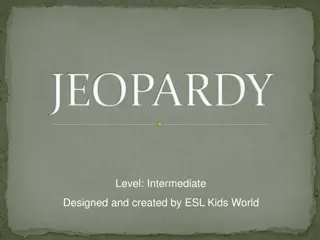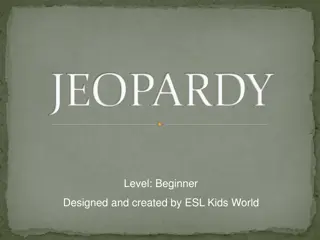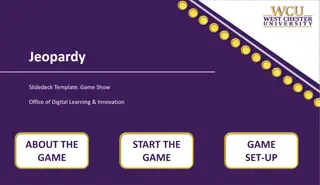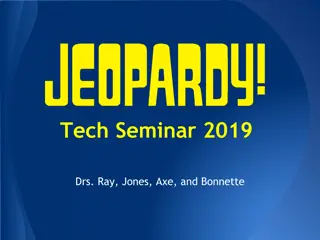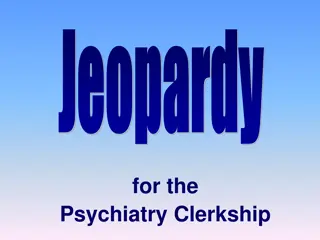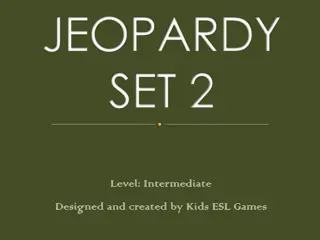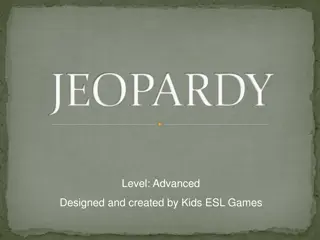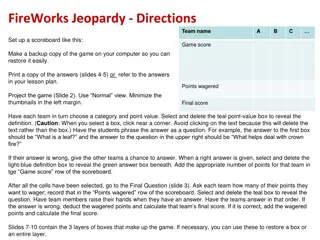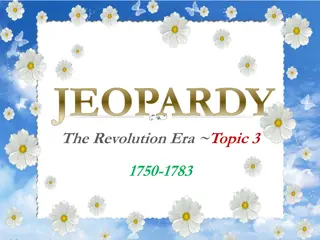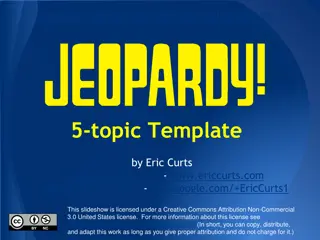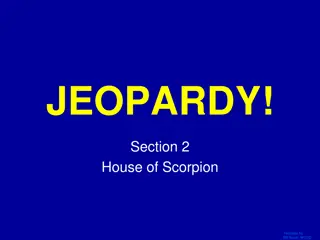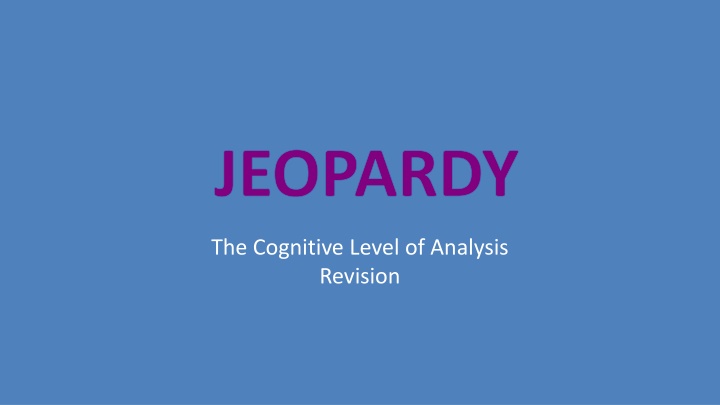
Revealing Cognitive Insights: Jeopardy The Cognitive Level of Analysis Revision
Dive into the world of cognitive psychology with Jeopardy The Cognitive Level of Analysis Revision, exploring topics like learning, memory, intelligence, and more. Discover famous case studies, ethical considerations, and the perspectives of different psychologists on studying cognitive processes.
Download Presentation

Please find below an Image/Link to download the presentation.
The content on the website is provided AS IS for your information and personal use only. It may not be sold, licensed, or shared on other websites without obtaining consent from the author. If you encounter any issues during the download, it is possible that the publisher has removed the file from their server.
You are allowed to download the files provided on this website for personal or commercial use, subject to the condition that they are used lawfully. All files are the property of their respective owners.
The content on the website is provided AS IS for your information and personal use only. It may not be sold, licensed, or shared on other websites without obtaining consent from the author.
E N D
Presentation Transcript
JEOPARDY The Cognitive Level of Analysis Revision
The Cognitive Level of Analysis General Learning Outcomes Studies Famous Cognitive Case Emotions Reliability of memory Models of memory 200 200 200 200 200 400 400 400 400 400 600 600 600 600 600 800 800 800 800 800 1000 1000 1000 1000 1000 Bonus Question: 5000 pts
Topic 1: 200 Question: Define Cognition and Provide two example of a cognitive process. Answer Cognition: The mental action or process of acquiring knowledge and understanding through thought, experience, and the senses Cognitive Processes: Learning, Memory, Intelligence, Thinking, Decision Making, Problem Solving Back
Topic 1: 400 Question: What research method was used by Brown & Kulik in their classic study of Flashbulb memory? Answer They used both structured interviews and questionnaires. Back
Topic 1: 600 Question: What ethical consideration may have been violated in Loftus s Lost in the Mall study? Answer Deception was used in a way that may have broken the trust of the participants and violated their right to informed consent. Back
Topic 1: 800 Question: Cognitive Psychology principles say that cognitive processes can be studied. What did the Behaviorists say about this? Answer Skinner and other Behaviourists believed that the mind was a black box that could not be studied. Only observable behaviour was able to be studied scientifically. Back
Topic 1: 1000 Question: Which research method was used by Bartlett in his War of Ghosts study? Answer It is a quasi experiment. There is no manipulation of an IV and the procedure does not have a control group. Back
Topic 2: 200 Question: According to Atkinson & Schiffrin, how do we transfer information from STM to LTM? Answer Through rehearsal. Back
Topic 2: 400 Question: What is one thing that schema theory can explain that Atkinson & Shiffrin s model cannot? Answer Memory distortion. Back
Topic 2: 600 Question: According to Atkinson & Shiffrin s model, what are the characteristics of STM? Answer STM is limited in both duration and capacity. Back
Topic 2: 800 Question: What evidence is there that STM and LTM may be in different memory stores? (Provide the name of the study and a short explanation) Answer Biological research: HM; Serial Position Effect (Glanzer & Cunitz). Back
Topic 2: 1000 Question: What phenomenon does Baddeley & Hitch s Working Memory Model explain which neither schema theory nor Atkinson & Shiffrin s model can? Answer Multi-tasking. Baddeley & Hitch s model has different short-term memory stores. Back
Topic 3: 200 Question: Define Reconstructive Memory Theory Answer Memory retrieval is an active process that involves the reconstruction of information from various parts of the brain. It means memories are literally reconstructed everytime you remember them Memories can be altered by irrelevant external cues and influences Back
Topic 3: 400 Question: What is serial position effect? Name the study that determined this theory and briefly describe the procedure Answer Remembering the 1st and last items in a series. Glasner & Cunitz: Read a list of words and asked participants to recall all the words they remember Back
Topic 3: 600 Question: What were the results/findings of Bartlett s War of Ghosts Study? Answer Participants changed the story as they tried to remember it (distortion) proving memory is an active process (Reconstructive Memory Theory) and that culture influences a schema Back
Topic 3: 800 Question: Describe 2 famous Memory studies done by Elizabeth Loftus Answer Loftus & Pickrell (Lost in the Mall Study) Loftus & Palmer (Car Crash Study) Back
Topic 3: 1000 Question: Which study is commonly known as the Yearbook Study ? What were the findings of the yearbook study Answer Bahrick et al (1975) This study found that recall of names and faces are highly reliable over time and that recognition tasks are easier than free- recall tasks Back
Topic 4: 200 Question: According to Brown & Kulik, which emotion is responsible for flashbulb memories? Answer Surprise. Fear. Back
Topic 4: 400 Question: Which event was used in 2 of 3 Flashbulb Memory Studies Brown and Kulik Sharot et al Bernsten & Thomsen Niesser & Harsch Answer Brown & Kulik- Assassination of JFK/MLK Sharot et al- 9/11 Bernsten & Thomsen- Danish Occupation & Liberation WWII Niesser & Harsch: The Challenger Explosion Back
Topic 4: 600 Question: List one limitation of the Berntsen & Thomsen (2005) Danish Memory Study Answer Impossible to establish which details of event that participants had observed or paid attention to Used network sampling method (many participants knew each other) and memories could be altered Back
Topic 4: 800 Question: Modern day research on Flashbulb Memory (Sharot et al) shows that which part of the brain may be responsible for the phenomena? Answer The amygdala. Back
Topic 4: 1000 Question: Describe the difference between Flashbulb memories in individualistic and collectivist societies (Kukofsky et al) Answer Individualistic Cultures: Personal significance and emotional intensity of events plays a large role in creating/identifying FBM Collectivistic Cultures: Personal significance plays a smaller role in creating identifying FBM Back
Topic 5: 200 Question: Why is memory often considered unreliable? Answer Because it is often reconstructed. Back
Topic 5: 400 Question: What did Neisser & Harsch find out about memory in their Challenger study? Answer That individuals level of confidence was very high for emotional memories, but the accuracy of the information was not highly reliable. Back
Topic 5: 600 Question: What did Loftus & Palmer find influenced one s memory? Answer Post-event information. Specifically leading questions. They changed the intensity of the verb (IV) and found that participants estimates of the speed of a car crash varied. Back
Topic 5: 800 Question: Name one study that shows that memory is reliable. Answer Yuille & Cutshall found that leading questions did not have an effect on recall of an actual crime. Bahrick et al found that people could still recognize faces in a high school year 48 years later with 70% accuracy. Bernsen & Thomsen s Danish partisan study. Back
Topic 5: 1000 Question: Which type of memory appears to be the most reliable and resistant to forgetting? Answer Procedural memories. Back
Bonus Question: 5000 pts. Question: Plaques, tangles and amyloid proteins are all associated with which cognitive disorder? Answer Alzheimer s disease. Back



